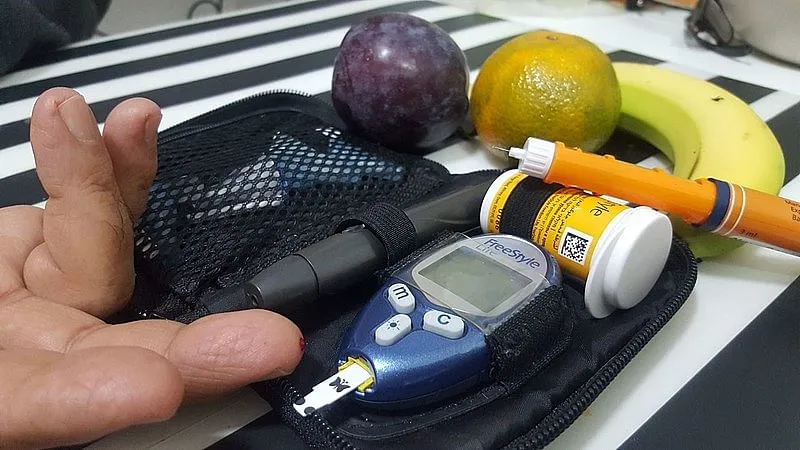The prevalence of obesity and associated type 2 diabetes have reached epidemic portions in world-wide. The alarming rise in Type -2 diabetes in Jammu and Kashmir is a big challenge in already collapsed health sector.
In a worrying trend, Sher-e-Kashmir Institute of Medical Sciences (SKIMS) Soura has registered over 700 cases of Type 2 diabetic cases of adolescents below the age group of 25 in the last two years.
According to an official data, there is a 20 percent increase in the cases over the past few years which doctors said is alarming in the valley.
In 2015, Type 2 diabetes was found only in 5 percent in the age group between 10 to 25 years.
Doctors said that cases in this age group have shown a steep rise in Kashmir and it is shocking.
The growing cases of Type 2 diabetes in adolescents and children is a “cause of great concern.”
Type 2 diabetes is now common among adolescents below the age group of 25. This year, the occurrence of Type 2 diabetes among youngsters below 25 years have increased by 15 percent which is alarming and needs to be taken care of. It is 20 percent now.
In the past few years, the department used to receive cases of Type 1 diabetes. But the situation is worse now, Type 2 diabetes is quite prevalent.
According to the doctors reasons behind diabetes and other diseases is only bad lifestyle. People especially youngsters, adolescents and children should bring changes in their lifestyle. Lifestyle diseases are connected with the way people live, eat, sleep and handle stress in life.
Most of the patients do not exercise and eat a healthy balanced diet. Youngsters mostly spend time indoors which leads them into trouble.
Doctors said that it is important to limit intake of junk food, limit daily carb intake, add protein, food rich in fibre in your diet, take plenty of fluids, eat fruits and vegetables and do not forget to burn calories.
High calorie diet, obesity, lack of physical activity and stress are the major reasons for lifestyle diseases in Kashmir.
Youngsters and children who have a family history of diabetes should get screened once in every year. In order to control diabetes, youngsters should avoid processed food, fats, butter, oil, chocolates, and cold drinks. They can take rice but in less quantity. Outdoor activities, sports, exercise are highly encouraged.
According to the Lancet study, the prevalence of type 2 diabetes in adolescents and young adults is dramatically increasing. Similar to older-onset type 2 diabetes, the major predisposing risk factors are obesity, family history, and sedentary lifestyle.
Myocardial infarction (MI)
Patients with diabetes are five times more likely to experience their first Myocardial Infarction (MI) than a population with comparable risk factors but no diabetes. People with diabetes who have previously experienced a MI are twice as likely to experience another one. These results suggest that the risk for a MI in people with diabetes who haven’t already experienced one is comparable to that in patients without diabetes who have already experienced a MI. Patients with diabetes have a worse long-term prognosis following a MI, which increases the risk of congestive heart failure and death. Even those who just have insulin resistance—often a prodrome of developing T2DM—have a higher chance of getting cardiovascular disease.
Treatment: lifestyle adjustments and risk factor management
Everyone agrees that leading a healthy lifestyle is important for managing diabetes. The development of healthy self-care habits, such as exercising, eating a nutrient-rich food, and managing blood sugar, is essential to preventing disease. Smoking, alcohol use, and diet make up the three main modifiable risk factors for diabetes within healthy living.
Diet
Understanding diabetes has long centred on diet, with early records of the disease’s symptoms being linked to eating foods high in sugar and carbohydrates. Diet in diabetes (type 1 and type 2) aims to lower risk of diabetes and CVD by encouraging good dietary selections.
The American Diabetes Association (ADA) advocates a diet that helps people with diabetes attain and maintain blood glucose levels as close to normal as feasible, as well as a lipid and lipoprotein profile that lowers the risk of vascular disease and promotes stable blood pressure.
The underlying mechanisms required to control glucose metabolism and effectively manage diabetes, whether alone or in conjunction with pharmacological therapy, include adhering to the prescribed amounts of macro and micronutrients of carbs, fat, protein, vitamins, and minerals.
Studies have linked a high-sugar diet to a lower risk of developing T2DM, and those who consume large amounts of fried, sweet, and red meat had a higher risk of developing insulin resistance and T2DM. The latter three diets provided better glycaemic control in people with T2DM, according to a systematic review of low carbohydrate, fasting, macrobiotic, Mediterranean, vegetarian, and vegan diets.
DISCLAIMER: The views and opinions expressed in this article are the personal opinions of the author.
The facts, analysis, assumptions and perspective appearing in the article do not reflect the views of GK.






